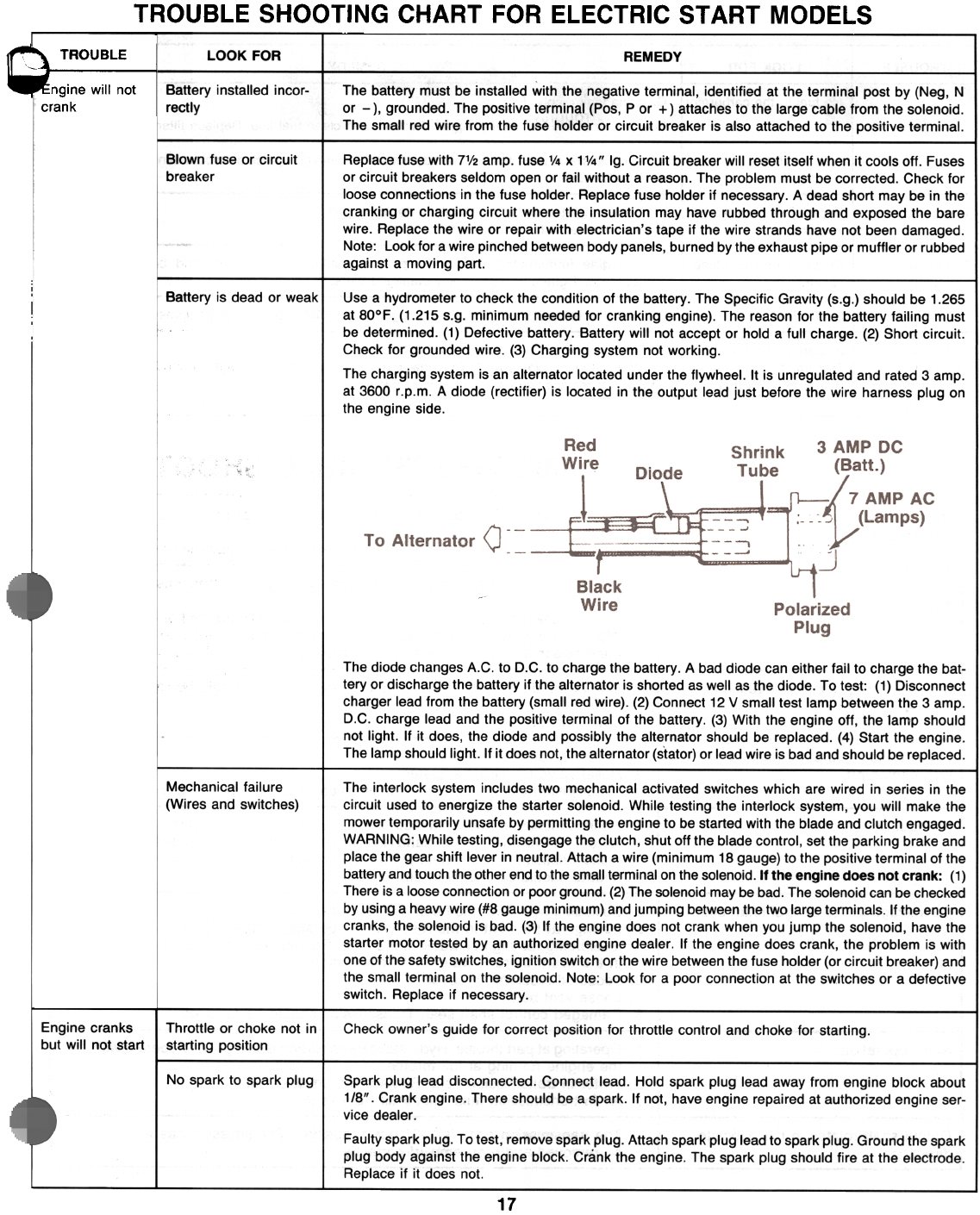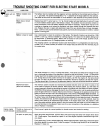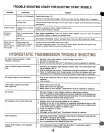
TROUBLE
SHOOTING CHART FOR ELECTRIC START MODELS
TROUBLE
ngine will not
crank
LOOK FOR
REMEDY
Battery installed incor-
rectly
The battery must be installed with the negative terminal, identified at the terminal post by (Neg, N
or -). grounded. The positive terminal (Pos. P or +) attaches to the large cable from the solenoid.
The small red wire from the fuse holder or circuit breaker is also attached to the positive terminal.
Blown fuse or circuit
breaker
Replace fuse with 71/2 amp. fuse V4 x 1 V4" Ig. Circuit breaker will reset itself when it cools off. Fuses
or circuit breakers seldom open or fail without a reason. The problem must be corrected. Check for
loose connections in the fuse holder. Replace fuse holder if necessary. A dead short may be in the
cranking or charging circuit where the insulation may have rubbed through and exposed the bare
wire. Replace the wire or repair with electrician's tape if the wire strands have not been damaged.
Note: Look for a wire pinched between body panels, burned by the exhaust pipe or muffler or rubbed
against a moving part.
Battery is dead or weak I
Use a hydrometer to check the condition of the battery. The Specific Gravity (s.g.) should be 1.265
at 80°F. (1.215 s.g. minimum needed for cranking engine). The reason for the battery failing must
be determined. (1) Defective battery. Battery will not accept or hold a full charge. (2) Short circuit.
Check for grounded wire. (3) Charging system not working.
The charging system is an alternator located under the flywheel. It is unregulated and rated 3 amp.
at 3600 r.p.m. A diode (rectifier) is located in the output lead just before the wire harness plug on
the engine side.
The diode changes A.C. to D.C. to charge the battery. A bad diode can either fail to charge the bat-
tery or discharge the battery if the alternator is shorted as well as the diode. To test: (1) Disconnect
charger lead from the battery (small red wire). (2) Connect 12 V small test lamp between the 3 amp.
D.C. charge lead and the positive terminal of the battery. (3) With the engine off, the lamp should
not light. If it does, the diode and possibly the alternator should be replaced. (4) Start the engine.
The lamp should light. If it does not, the alternator (stator) or lead wire is bad and should be replaced.
Mechanical failure
(Wires and switches)
The interlock system includes two mechanical activated switches which are wired in series in the
circuit used to energize the starter solenoid. While testing the interlock system, you will make the
mower temporarily unsafe by permitting the engine to be started with the blade and clutch engaged.
WARNING: While testing, disengage the clutch, shut off the blade control, set the parking brake and
place the gear shift lever in neutral. Attach a wire (minimum 18 gauge) to the positive terminal of the
battery and touch the other end to the small terminal on the solenoid. If the engine does not crank: (1)
There is a loose connection or poor ground. (2) The solenoid may be bad. The solenoid can be checked
by using a heavy wire (#8 gauge minimum) and jumping between the two large terminals. If the engine
cranks, the solenoid is bad. (3) If the engine does not crank when you jump the solenoid, have the
starter motor tested by an authorized engine dealer. If the engine does crank, the problem is with
one of the safety switches, ignition switch or the wire between the fuse holder (or circuit breaker) and
the small terminal on the solenoid. Note: Look for a poor connection at the switches or a defective
switch. Replace if necessary.
Engine cranks
but will not start
Throttle or choke not in
starting position
Check owner's guide for correct position for throttle control and choke for starting.
No spark to spark plug
Spark plug lead disconnected. Connect lead. Hold spark plug lead away from engine block about
1/8". Crank engine. There should be a spark. If not, have engine repaired at authorized engine ser-
vice dealer.
Faulty spark plug. To test, remove spark plug. Attach spark plug lead to spark plug. Ground the spark
plug body against the engine block. Crank the engine. The spark plug should fire at the electrode.
Replace if it does not.
17


















